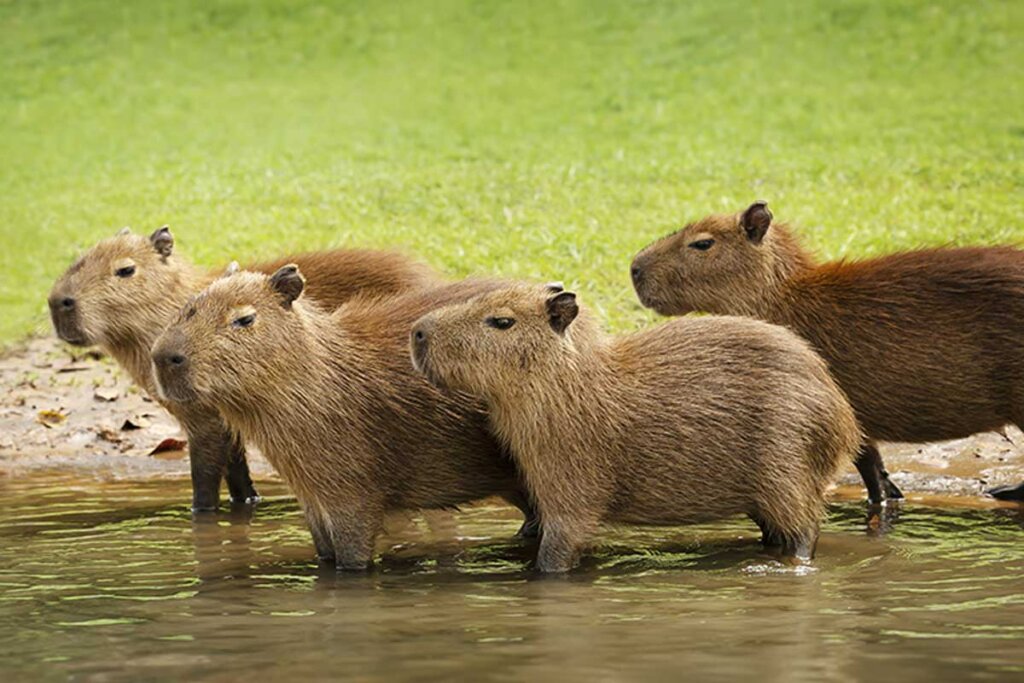Capybara Breeding in Captivity
The capybara is the largest rodent in the world, weighing up to 80 kg (176 lbs). It’s widely distributed throughout the South American plains, from Panama to Argentina. Thanks to capybara breeding in captivity, this species can live up to ten years. It’s also possible to obtain superior-quality meat and leather.
Until recently, capybara products were obtained from illegally hunted capybaras. Therefore, capybara breeding has also helped to improve their survival, not to mention the economic diversification it provides to the South American livestock sector.
General information on capybaras
The capybara, whose scientific name is Hydrochoerus hydrochaeris, is a sedentary, reddish-brown furred animal. Although one of its extinct relatives, the giant Protohydrochoerus hydrochaerus, had running habits, the capybara is slow and clumsy. It’s also unable to regulate its body temperature and can suffer from thermal shock after a long run.
It is, however, a skilled swimmer and often stays in the water for several hours. It hardly ever leaves the water, as it needs it for bathing, drinking, and shelter. A sign of its adaptation to the aquatic environment is the fold that closes the ear canal when the animal submerges. The legs are also adapted to swimming, with a thick interdigital membrane that facilitates its movements.
The high level of its snout helps it to swim, with only its the nose showing, although it’s also capable of remaining submerged.
Capybara breeding in captivity
We’ll now discuss some of the main needs of capybara breeding in captivity.
Food
The unique adaptation of capybaras to water makes it necessary to include fish in its diet. But, otherwise, it’s almost exclusively herbivorous. And while it may feed on aquatic plants, it prefers riverbank grasses with tiny, tender shoots. It also tends to gnaw on tree bark, with its with powerful incisors, like other rodents have.
During the day, the capybara prefers to lie among aquatic plants or graze on the surrounding grass. Towards midday, when the heat rises, it will dive into the water to regulate its temperature and try to get rid of possible insects. In the middle of the afternoon, and until the early evening, is when it will be devoted to eating in earnest.
Although in quiet environments it can be active during the day, it’s an animal with crepuscular and nocturnal habits.
Aquatic courtship, one of the main peculiarities of capybara breeding in captivity
We have already seen how important it is for capybaras to have aquatic facilities when they’re being bred. And, if they’re also intended to reproduce, the importance is even greater.
When the male begins to chase the female, it means that courtship has begun. She will seem to be indifferent, but guides the male to the water, where they’ll both swim. The female dives several times, disappearing from the surface and moving away from the male, who comes back to look for her.
And when this courtship is over, in the shallower area, copulation takes place. The mating is brief, just a few seconds. Then, the male and female swim together and repeat the whole process several times.
In nature, it isn’t uncommon for several pairs to copulate at the same time and in the same small lagoon, exchanging partners.
Gestation
After a relatively long gestation period, the young are born at an advanced stage of development. In fact, at ten days of life they’re already able to walk following their mother.
In the wild, the female breastfeeds the young until they are four months old. In production, an earlier weaning is recommended, around two months of age.
In view of these needs, in captivity it’ll be necessary to provide these animals with facilities with two separate areas: one for reproduction, with a roofed area and the corresponding pool for copulation, and another for calving.
Coexistence in groups
Capybaras have gregarious habits and live in sedentary herds made up of individuals of both sexes and different ages.
Each herd constitutes a closed society, with a hierarchical organization that is well assimilated by its components. The number of individuals in each herd varies. In El Palmar National Park, in Argentina, groups of twenty to sixty members have been observed.
Final note: valorization of the species
Both for its extraordinary meat and its delicate hide, the capybara can be considered a significant productive species.
The meat of this species is lean, with lower fat and cholesterol content, and of good quality. It is, therefore, an important resource for millions of people among the rural population in most of Latin America. In addition to traditional uses, this meat lends itself well to sausage and canning.
It might interest you...All cited sources were thoroughly reviewed by our team to ensure their quality, reliability, currency, and validity. The bibliography of this article was considered reliable and of academic or scientific accuracy.
- Hydrochoerus hydrochaeris [Internet]. Es.wikipedia.org. [cited 21 August 2020]. Available from: https://es.wikipedia.org/wiki/Hydrochoerus_hydrochaeris
- Manual para manejo de capibaras (Hidrochaeris hidrochaeris) [Internet]. 2011 [cited 21 August 2020]. Available from: http://www.fao.org/climatechange/34141-0647a3f33cc0ab8d6a898a53133d8085e.pdf
- Carpincho [Internet]. Turismo de Aventuras Pampas Argentinas S.A; 2006 [cited 21 August 2020]. Available from: http://produccion-animal.com.ar/produccion_carpinchos/08-carpincho.pdf
- Cría de carpinchos en cautiverio [Internet]. 2002 [cited 21 August 2020]. Available from: http://produccion-animal.com.ar/produccion_carpinchos/05-cria_carpinchos_en_cautiverio.pdf
